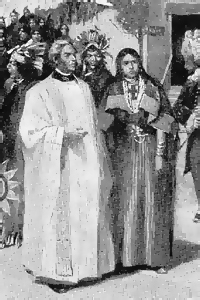Mary Musgrove
b. circa 1700, Coweta Town on the Ockmulgee River, Georgia; d. 1763 or 1765, St. Catherines Island, Georgia
The English colonizers of Georgia met their match in Mary Musgrove. Born Coosaponakeesa, to an English father and a Yamacraw mother of the Creek Nation, Mary straddled two cultures, speaking both English and Muskogee. In 1716, she married an English fur trader, John Musgrove, and they lived in her native village of Coweta, the Creek capital. In 1732, the Musgroves established a trading post at Yamacraw Bluff. The next year, General James Oglethorpe arrived with his party of English settlers, landing at Yamacraw Bluff, soon to become the town of Savannah. Oglethorpe employed Mary as an interpreter, but she became much more than that; she advised him on Indian affairs and mediated between the English colonists and the Creeks. She became a fundamental actor in the new colony, ensuring peace between the various factions. As such, the colonists and the Creeks had an interest in keeping her happy. Mary was well aware of her power and capitalized on the opportunities it brought her. The trading post was ideally situated for doing business with settlers. The Creek granted her various parcels of land, including Yamacraw Bluff and the islands of Ossabaw, Sapelo, and St. Catherines, off the coast of Georgia. Meanwhile, widowed twice, she married a third time in 1744, to the clergyman Thomas Bosomworth. This marriage placed her in “respectable” English society. Mary’s later years were absorbed in obtaining title to her lands under English law. Her petitions created a great deal of controversy. Oglethorpe, who had great respect for her, returned to England in 1743; the new administrators dismissed her as a troublemaker. In 1755, she went to London and presented her claims before the Board of Trade. The commissioners were unimpressed—in fact, they thought she was a swindler—but also realized that alienating her could compromise the colony’s security. They referred the case back to the Georgia courts. A compromise was reached in 1760—Mary was granted title to St. Catherines and £2,100 pounds in exchange for relinquishing the other lands.

Mary Musgrove with her third husband, the Reverend Thomas Bosomworth. From Lawton B. Evans, First Lessons in Georgia History (New York, American Book Co., 1913)
Related Place Setting
Related Heritage Floor Entries
- Anaconda
- Awashonks
- Maria Bartola
- Ana Betancourt
- Capillana
- Rosa Chouteau
- Josefa de Dominguez
- Isabel de Guevara
- Juana de la Cruz
- Ehyophsta
- Candelaria Figueredo
- Maria del Refugio Garcia
- Jovita Idar
- Marie Iowa
- Kaahumanu
- La Malinche
- Maria Montoya Martinez
- Carlota Matienzo
- Luisa Moreno
- Isabel Pinochet
- Pocahontas
- Magda Portal
- Maria Luisa Sanchez
- Laura Torres
- Ojelia Uribe de Acosta
- Saaredra Villanueva
- Andres Villareal
- Teresa Villareal
- Nancy Ward
- Wetamoo
- Sara Winnemuca
- Xochitl